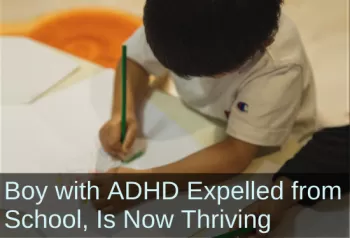Primitive Reflex Integration Case Studies
Therapist Helps Boy with ADHD Show His Skills and Gain His “First True Success”
Reflex integration and rhythmic movements help with behavior issues and poor impulse control
This preschooler with ADHD and developmental delay had been expelled from school due to poor behavior and impulse control. Learn how rhythmic movements and reflex integration helped improve his sensory processing, body awareness, emotional regulation, and attention—transforming his behavior and enabling him to thrive in a general education classroom!
Submitted by Kerbe Shephard, OTR/L

| Before | After |
|---|---|
| Expelled from school | In a new school and doing well in a general education classroom |
| Struggled at school | Thriving in school |
| Poor impulse control | More positive behavior at home |
| Poor coordination | Better body awareness |
Kenny is a 5-year-old boy who has developmental delay and a diagnosis of ADHD. He is a triplet who was born at 32 weeks with no major complications. He demonstrated deficits in postural control, shoulder stability, and overall body awareness that were impacting his ability to participate in age appropriate occupations. He also demonstrates deficits in sensory processing skills, specifically vestibular input in the form of gravitational insecurity, as well as auditory hypersensitivity. Kenny exhibits an array of retained primitive reflexes, resulting in poor execution of overall coordination, attention, social-emotional regulation, and developmentally appropriate skills. Kenny was expelled from his previous school due to his inability to control his behavior and impulse control.
After evaluating Kenny and taking this [Brain and Sensory Foundations] course, I decided to alter my plan of care and really focus on rhythmic movements, FPR [Fear Paralysis Reflex] integration, and reflex integration through play-based activities. His mother was always present for his sessions, and practiced the rhythmic movements and FPR integration activities during the session for proper carryover. Kenny began rhythmic movements and integration exercises in January 2021, and continues to move through the reflex integration exercises.
At first, Kenny was unable to maintain positioning for rhythmic movements for more than 2-3 seconds at a time and he could tolerate the upper or bottom half of his body for tapping before giggling uncontrollably. We respected his body and allowed his tolerance to grow over several weeks.
We would incorporate movements [from the Brain and Sensory Foundations course] with moderate to maximal assistance initially, and began many TLR-based tasks [Tonic Labyrinthine Reflex].
Fast forward to today, and Kenny is thriving in his new school in a general education classroom. He has been in this new school for over 4 months and has only received two “bad reports”. His mother continues to do rhythmic movements and FPR daily, and he even asks for them sometimes when he is feeling extra “wiggly”! This has been the first true “success” for Kenny, as they have tried many various settings, therapies, and treatment options! She even sees the carry over at home.
Kenny was one patient I didn’t think would respond well to this movement technique because of his spontaneity and impulse control. It is awesome to see the transition of a child who finally understands his body and is able to show his true skills!
(Edited, emphasis added)
*Disclaimer: The activities in the Brain and Sensory Foundations curriculum make use of the natural processes of neuroplasticity and development that are innately wired in the design of human beings to promote maturity and function. These activities appear to calm, organize, and mature the neuro-sensory-motor systems just as we see in the healthy development of human infants. Individual results may vary, and we do not claim to offer a diagnosis or cure for any specific condition or disorder. The Brain and Sensory Foundations activities appear to improve overall functioning resulting in measurable improvements for a range of conditions as demonstrated in over 1800 case studies from participants.

